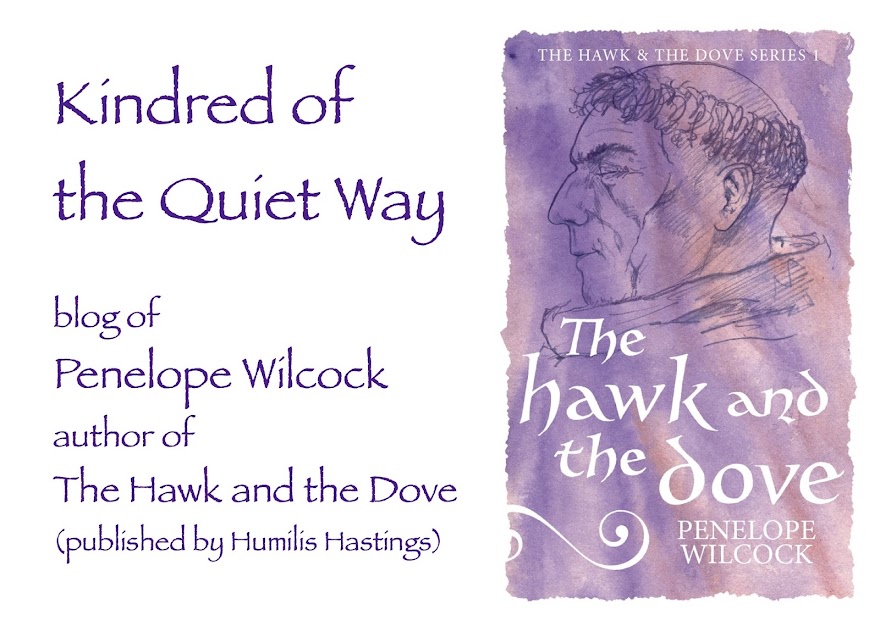When we moved to this house, there was no front garden, just a paved forecourt to park a car.
Last autumn we made a garden again. I sold my car. I pulled up the paving slabs and advertised them on Freecycle, where they were snapped up immediately and a man with a lorry came and took them away.
I thought it would be simple from there - just digging up the compacted earth and adding a bit of compost, maybe some sand to clear: but no! Under the slab was a thick layer of concrete that defied Badger's best efforts with his pick-axe. What to do what to do.....? (nothing for a while)
Then I began to go to Quaker meeting, and discovered a husband and wife a few doors along from me to be Friends. I was so pleased. The lady had seen my halted efforts with the garden-to-be, and was able to tell me her neighbour is a builder, then engaged in some work on her house.
A young man working for this builder took an afternoon out to come over with a jack-hammer and break up the concrete - which, along with the sand that had lain on top of the concrete, he was able to recycle in the ongoing works on our neighbours' home.
He had quoted me too low a price for this work - it took much longer than expected because the concrete was so thick. I thought he should be paid more, he said 'No! No! A quote's a quote!'
We argued back and forth a little, and I persuaded him to accept a bit extra - not, I think, the usual disagreement in such circumstances!
Then Badger bought some bags of compost and rotted manure, and we heaved it all in. My dear friend Pearl had given me £50 for some plants. I got penstemons, primula, alyssum, snow-in-summer, some hardy plants that you get in hanging baskets with small umbelliferous flowerheads in a variety of colurs (peachy pink here), a Peace rose and a white rose (Silver Wedding I think), a small Southernwood plant, some pinks - oh, lots of things!
I already had two lavenders outgrowing their pots and a rosemary needing transplanting. A lady on Freecycle responded to my posted request for plants and brought me wild geraniums and sedums and a buddleia. I was delighted with them, but they will stay in their pots, because they are somewhat invasive.
On the day we made the flowerbed, the first plants to go in were the lavenders - and even before I'd finished bedding them in the earth, a bee came to get involved.
My Quaker friends had brought me a campanula, which went at the front of the bed near where people pass by, so everyone could see its ravishingly soft sweet blue and green.
Towards the end of the autumn, beginning of the winter, we found a dwarf stock apple tree reduced to £6 at the garden centre - so that took pride of place in the centre of the garden.
Around the edges of this flower-bed remain paving slabs left for paths to the front door and the side gate, and along the front for the plants as they grow to spill onto without tripping up passersby. On the paths I am gathering plants in big pots - a curry plant, a euonymous, the geraniums and buddleia, and recently a big bay I transferred from its outgrown pot to a big blue-glazed one.
In the summer, I imagine many more trailing and sprouting, climbing and overspilling - I managed a brief riot of nasturtiums last year before the frosts.
Already the birds perch in the little apple tree on their way by - mostly visiting the glorious, berry-laden pyrocanthus that curves over our neighbour's fence.
Today I planted out a small clump of snowdrops, a tiny white hyacinth, and a number of primroses, some with rose pink flowers, some with pale green flowers.
It's such a small plot of land, too tiny to make much of a difference, but I'm hoping it will be part of the Revolution - the real Green Revolution, not the so-called one that keeps farmers in thrall to big businesses, selling them seeds for plants that won't yield seeds they can keep for next year.
To avoid the pendulum swing of drought and flood we have brought upon ourselves, we have first to understand the movement of water through the landscape. Root mats, plant bodies, serve to slow down the passage of the water, and hold in place the top layer of earth we rely on for fertility. If the earth is raw to the elements, it is vulnerable to being washed away. If it is covered by concrete or decking, the water never touches the earth, but floods over the top, bypassing some areas, torrenting through others. Plants gentle and slow the passing of water through the landscape, allowing it to soak without flooding the thirsty earth. Plants are the blessing of the earth.

3 comments:
Can we see some photos?
:)
You can see the beginnings of the garden here: http://www.flickr.com/photos/34733616@N03/
Tsk. No, I don;t think you can... I have not yet mastered the technology to take you to my Flickr set of photos of the garden... will continue to try...
Post a Comment